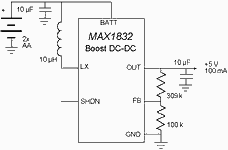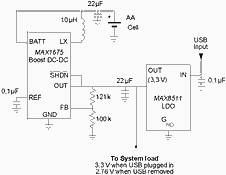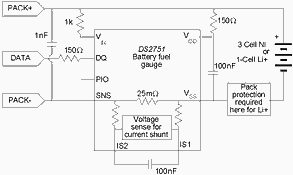
What follows is a short list of common 'sins' made by designers of battery-powered products. Although much of my contact with portable devices comes from a design perspective, most of these items make this list as a result of viewing products from a consumer's point of view.
In spite of accomplishing amazing feats of technology, many products still manage to frustrate and disappoint consumers for the simple reason that they run out of power. On some occasions, the noted transgressions are unavoidable, but more often than not, they occur simply because they, or their consequences, are not considered.
Not necessarily in order of importance:
1. Friends do not let friends use AAA or 9 V batteries
AAA and 9 V alkaline 'transistor radio' batteries have significant disadvantages compared to AA cells. Both have very poor output impedance and so their already limited capacity is made even worse as losses increase with load peaks. From typical manufacturer data, AA capacity is 2,5 times that of AAA. Except in cases where mechanical design prohibits their use, AAA cells should be avoided. AAAs admittedly are smaller than AAs, but frequently they are used where there is plenty of room for larger cells.
9 V 'transistor radio' batteries have some justification because they allow a 5 V system to be powered with a cheap linear regulator. For low-current loads, 9 V capacity is comparable to AA. However, 9 V batteries are made from six tiny series connected cells, so output resistance is high and capacity is very dependent on load current. This is fine for a smoke alarm, where the battery is replaced twice a year. But with larger loads, frequent battery replacement is expensive for the user, and the cell's poor output resistance compounds this problem. When comparing the capacity of AA and 9 V batteries, you should keep in mind that, for consumers, 9 V cells typically cost four times as much as AAs.
Due to modern low-cost DC-DC converters, it is very easy to efficiently generate a 5 V supply from two AA batteries (see Figure 1). The circuit includes reverse battery protection, which is built into the IC. The connection shown typically doubles the time between battery changes, and costs one-fourth as much for the user to operate, compared to 9 V batteries.

2. No off-state load current
Alkaline batteries excel due to their very low self-discharge rate and low cost of implementation (no charger or AC power jack is needed). If power requirements are low, alkaline can be a great choice, but to be used properly, quiescent load, or sleep current, must be reduced with religious conviction. A common power-system design mistake is focusing only on a product's operating efficiency while ignoring 'off' or 'sleep' current. Even tens of microamps of wasted current can drain cells, causing intermittently-used products to require frequent cell replacement. Ironically, this design mistake is more common today than it was years ago because 'software switches' have replaced mechanical switches, which completely disconnected the battery.
With a software switch, the system remains alive but goes into a (hopefully) low current state where only an ON/OFF key is scanned. Such systems can have excellent 'off' current drain because the static (unclocked) current drain of CMOS logic is essentially zero. The reality is that these systems often still drain the battery while off because of sloppy design where pull-up resistors continue to draw battery current or inactive system blocks are not powered down. There rarely is a legitimate reason for the off-state current of such systems to exceed a few microamps. Even 1- or 2-cell AA designs, where a boost DC-DC converter must run full time to maintain a logic supply, can now consume less than 2 μA with devices such as the MAX1722. With AA cells, this level of operating current is usually less than the internal discharge rate of the cells themselves.
3. No diode-OR-ing
The world needs a perfect diode with a 10 mV forward voltage drop and no reverse leakage. To date, Schottky diodes are the best we have, with a forward voltage drop between 300 and 500 mV. Unfortunately, for many voltage selection designs, even a Schottky is not good enough. It makes little sense to use a cutting-edge high-efficiency voltage converter, only to waste the power saving in a steering diode's forward voltage drop. If conserving battery energy really is a priority in a low-voltage system, power MOSFET switches should be used instead of diodes. Given SOT devices with on-resistances in the tens of milliohms, MOSFET forward drops are negligible at portable product current levels.
The way to determine if MOSFETs are needed for power steering is to compare the (diode or MOSFET) voltage drop to the battery voltage and treat this ratio as an efficiency loss. If a Schottky diode with a 350 mV forward drop steers the output of a (nominally 3,6 V) Li-Ion battery, the loss is 9,7%; with two AA cells (nominally 2,7 V), the loss would be 13%. In a low-cost design, these losses may be acceptable, but the cost of a high-efficiency DC-DC converter should be weighed against the cost of the 13% or 9% improvement gained from a steering-diode-to-MOSFET upgrade.
In some cases, steering diodes and MOSFET switches can be avoided with careful system design. In Figure 2, system power is handed off between a single AA cell and a USB input without using MOSFET switches. When USB power is plugged in, no current is drawn from the AA cell. The MAX1675 boost converter's shutdown (SHDN) input does not need to be activated to prevent AA drain when USB power is connected, because the MAX8511 LDO pulls the boost output from 3 V up to 3,3 V in this situation. This stops the boost converter from draining the battery.

4. No 10 kΩ pull-ups
Most portable products (PDAs, cameras, etc) are so complex that their design is spread over many engineering groups. These groups focus on their immediate goals and may not fully consider the impact on other parts of the design. Most digital designs contain pull-up resistors. Taken individually, the current flowing in a pull-up resistor would likely not have a huge impact on power consumption. However, a system full of pull-up resistors can waste significant battery energy. In many cases, pull-up resistors can be eliminated entirely by using logic that is active in both states. But even when resistors are needed, they can often be raised to 1 MΩ or more if speed is not a concern. Be sure to consider the most common state of the pull-up (is it high impedance or drawing current) and reduce the pull-up current to the lowest possible value (highest possible resistance).
5. No iron-core 50/60 Hz 'wall warts'
This is really not a battery issue, but it is sufficiently related to warrant mention. From the viewpoint of a consumer of portable devices, nothing deflates a product's value like packing a large heavy AC adapter with a portable product that is pitching small size and weight as a feature. A manufacturer could not send a more conflicted message.
Small, light switch-mode AC adapters are now commonplace. Yes, they cost somewhat more than iron-core 50/60 Hz 'wall warts', but their advantage to the customer justifies the expense in all but the cheapest applications.
6. Use the right battery
All portable devices have a pattern of use that customers tend to follow as a result of their interaction with the device. Customer satisfaction (or dissatisfaction) depends largely on how the product fits, or conflicts with, this pattern. For example, it is a distraction when a product requires a user to be hyper-aware of the battery. The best products make the battery 'disappear' with either very infrequent cell replacement (eg, TV remote controls) or charging, or with unobtrusive charging (eg, electric toothbrushes). It is important to match the battery (most commonly Alkaline, NiMH, and Li-Ion) to a product's use pattern so that customers are not forced to think about batteries more than the device's intended function.
As mentioned above, alkaline cells are not rechargeable but feature a very low self-discharge rate and low cost of implementation (no charger or AC power jack is needed). If power requirements are low, alkaline can be a great choice. When operating loads are too great for alkaline batteries, rechargeable batteries are required. The trick then is to make the rechargeable battery as unobtrusive as possible.
Of the two main rechargeable choices, NiMH or Lithium-Ion, the lower cost of NiMH can make sense when the product's use pattern is not unhealthy for the cells. This consideration is especially important in low-cost products where sophisticated charging is not affordable. NiMH cells prefer full charge/discharge cycles and hence fit best in products that are frequently used to exhaustion, such as power tools. Another use pattern that sometimes fits NiMH is as alkaline 'replacements', where cells are removed from the device when depleted and then charged in an external charger. This is common in digital cameras, but still has the disadvantage of requiring a lot of attention from the consumer. Products like cellphones do not conveniently fit the full charge-discharge pattern. Cellphones are charged regularly (overnight) but drained sporadically. These products need Lithium-Ion's higher power-to-weight ratio, low self-discharge, and affinity for small charge-discharge cycles. Consumers thus devote little effort to 'battery management' and instead simply focus on the product.
7. Do not skimp on bypassing, especially at low voltage
Low-voltage battery systems incorporate boost converters to supply system voltages. These converters take constant power from the battery, so when the battery voltage falls, input current rises, which exacerbates problems caused by source resistance. In addition, DC-DC converters take power from the input source in pulses, even when the load is constant. This dynamic loading aggravates the losses due to battery resistance and other factors that add to input resistance. Since losses through resistors are proportional to the square of current, 'peaky' loads waste more power than continuous ones. That is why battery bypassing (with capacitance) is so important in systems that include DC-DC converters. If the current passing through input resistance can be made as close to DC as possible, the savings in consumed battery energy can be as much as 5%.
8. Do not fear dropout
Batteries are of course not perfect and have significant voltage variation during discharge. Lithium cells vary from 4,2 V down to 2,7 V. When generating a 3,3 V output, it might at first seem necessary to step up the battery voltage when it is low, but many 'Buck-Boost' power supplies add significant system cost and may not really add to battery life since their overall efficiency is not up to that of simpler buck-only DC-DC converters. With buck-only designs, the question then is how far down can the battery be run. The lower the battery can go, the longer the useful life. When the input and output of the regulator are nearly the same, the regulator is said to be in dropout. In the past, the dropout state was presented as an undesirable condition to be avoided. But when the economic advantages of simple buck designs are considered, it becomes worth the effort to consider a system's true minimum operating voltage.
Many contemporary LDOs and buck DC-DC converters are designed to operate in dropout with no ill effects. This allows the battery to operate down to the minimum possible voltage and thus permits the maximum energy to be drawn from the battery. The limits on this are determined by the minimum allowed system logic voltage as well as the dropout specs of the LDO or DC-DC converter. In most 3,3 V systems, logic devices allow a ±5% (or maybe ±10%) tolerance. That means a minimum of 3,15 V for a 5% system. If the system is not clocked at the maximum rate, the minimum operating voltage may be allowed to be even lower.
9. Do not skimp on the battery door (or compartment)
Again, this is not related to battery technology, but is a big issue with consumers and is a weak spot on many products. If battery replacements are to be frequent, the battery door needs to be up to the task of many operational cycles without breaking. Furthermore, it should not be difficult to operate. The need for good design here varies in proportion to the frequency of battery changes, particularly in products like digital cameras where NiMH cells are charged outside the camera and swapped in and out as they are charged.
10. Accurate battery gauges are not a waste of money
Products where accurate gas gauging is especially valuable are those with batteries that might not be fully discharged in one use. This of course could be true of nearly any battery-powered product, but is especially true for digital cameras, cellphones, and PDAs. Cameras in particular have a unique distinction in that they are used irregularly (so it is easy to lose track of the battery charge), but also are considered critical when they are used. Without good gas gauging, a digital camera runs a greater risk of running out of power and has a higher likelihood of doing so (and causing a missed shot) at an important moment.
Most designers of portable devices do not budget significant money for 'gas gauges' because they do not think that consumers value the feature. This thinking is flawed because even though battery-powered devices have been around for a while, consumers do not really know what they can expect and so have not seen the benefit of an accurate gas gauge. That, combined with the fact that many 'so called' gas gauges are so poorly implemented that they do not really work, has clouded the view of the real market and has 'programmed' consumers to expect the worst from battery gauges.
This need not be the case, as there are now integrated solutions to battery gauging whose cost is low enough to add real value to portable devices. One such device is the DS2751 shown in Figure 3. This device contains an internal current-sense resistor, has a 2 μA standby current, and communicates with the system over a 1-wire serial interface.

For more information contact CST Electronics, +27 (0)11 452 0706 or Electrocomp (Value Added Distributor), +27 (0)11 458 9000.
| Tel: | +27 11 608 0070 |
| Email: | [email protected] |
| www: | www.cstelectronics.co.za |
| Articles: | More information and articles about CST Electronics |
| Tel: | +27 11 458 9000 |
| Email: | [email protected] |
| www: | www.electrocomp.co.za |
| Articles: | More information and articles about Electrocomp |

© Technews Publishing (Pty) Ltd | All Rights Reserved